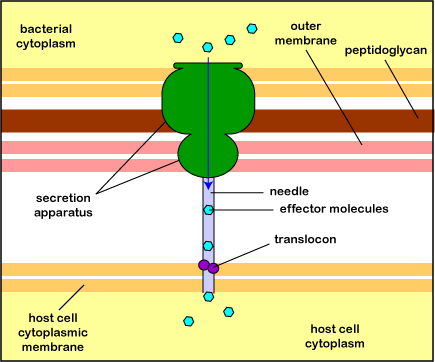
Many bacteria involved in infection have the ability to co-opt the functions of the host cell for the bacterium’s own benefit. This is done by way of bacterial secretions systems that enable the bacterium to directly inject bacterial effector molecules into the cytoplasm of the host cell in order to alter its cellular machinery or cellular communication. The most common type is the type 3 secretion system. A secretion apparatus in the cytoplasmic membrane and cell wall of the bacterium polymerizes a hollow needle that is lowered to the cytoplasmic membrane of the host cell and a translocon protein is then delivered to anchor the needle to the host cell. Effector proteins in the bacterium can now be injected into the cytoplasm of the host cell. The delivery system is sometimes called an injectisome.
Illustration ofThe Bacterial Type 3 Secretion System.jpg by Gary E. Kaiser, Ph.D.
Professor of Microbiology,
The Community College of Baltimore County, Catonsville Campus
This work is licensed under a Creative Commons Attribution 4.0 International License.
Based on a work at https://cwoer.ccbcmd.edu/science/microbiology/index_gos.html.
Last updated:October, 2018
Please send comments and inquiries to Dr.
Gary Kaiser